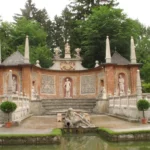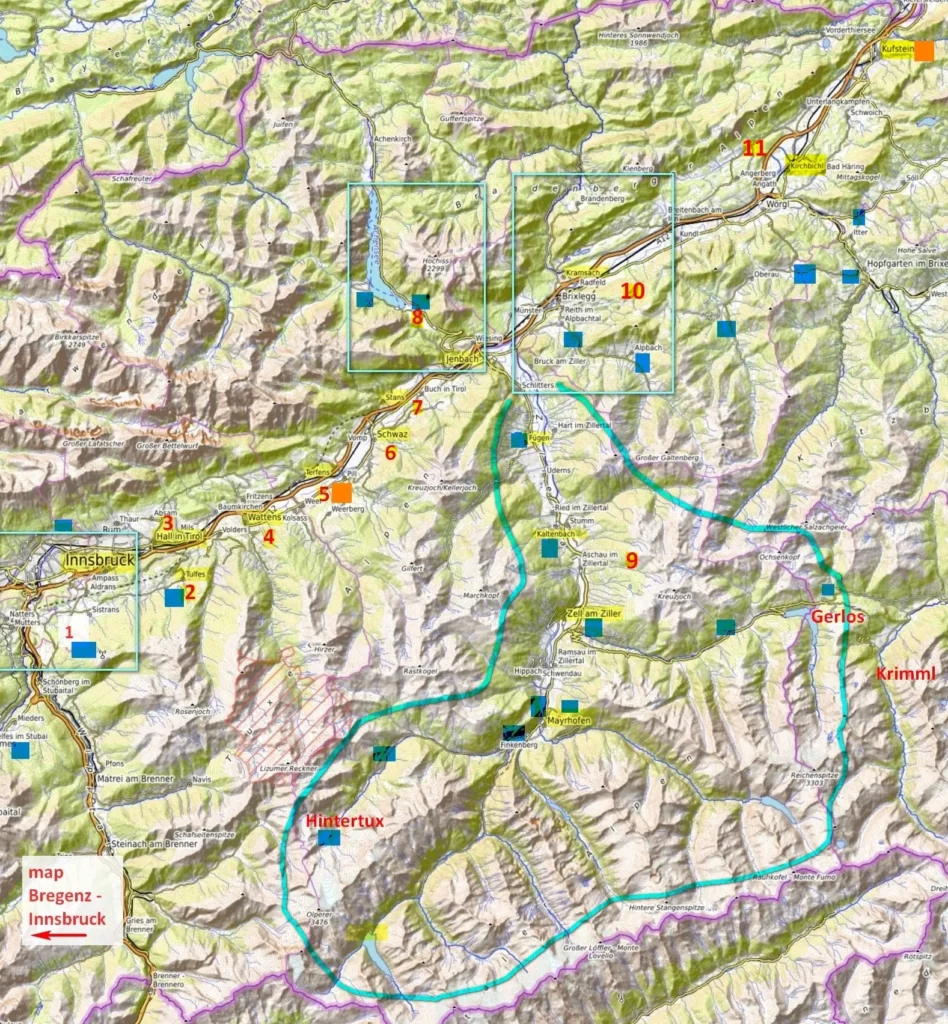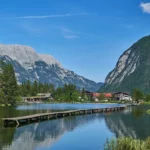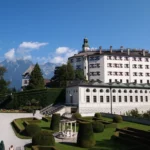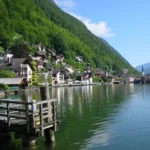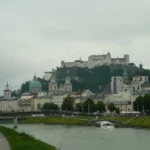Last Updated on 27/08/2024
Innsbruck enjoys an advantageous location at the crossroads of ravines and roads, where it was simply impossible not to grow big and prosperous. It can be pretty boring here when the weather is bad. But when the weather is nice, you can easily spend several days and not only see a small Innsbruck old town and Ambras Castle, but also hike in the mountains. It is one of the few large cities in the immediate vicinity of mountain peaks and ski slopes. It is not surprising that the Olympic Games have been held here twice.
Innsbruck. 2. Ambras Palace and mountains
Vorarlberg attractions. From Bregenz to Ischgl
Around Innsbruck. From Reutte to Brenner
Inn valley attractions on the map – from Innsbruck to Kufstein
Oetz Valley. Stuibenfall waterfall
What to do in Zell am See in summer
Bavaria. Allgäu. What to see
A little history
The Inn Valley, as excavations in the surrounding villages show, have been inhabited for over 3000 years. To protect their border and the road via Raetia (Verona – Brenner Pass – Augsburg), the Romans built in 15 BC. Veldidena‘s camp (now Wilten is a district of the city near the station). The camp was destroyed during the Great Migration.
The area passed into the possession of the Bavarian dukes and subsequently the Bavarian Counts Andechs. In 1133, the counts built a market settlement on the left bank of the Inn (now the St. Nicholas area – across the river from the old city). On the right bank were the possessions of the Wilten monastery, which in 1180 also passed to the counts of Andechs in exchange. This is how a settlement with market rights called Inspruke (bridge over Inn) was created. By 1205, the settlement acquired the status of a city and quickly began to grow and grow rich, thanks to customs duties, since all merchants passed this route from south to north. City rights were confirmed and expanded in 1239.
With the death of the last Count Andechs in 1248, the city passed into the possession of the Counts of Tyrol, the capital of Tyrol was Meran (now in South Tyrol in Italy).
In 1300, via Raetia was so good, that carts could pass through it, while other alpine passes were for a long time pack roads. At the same time, the city hospital was founded.
In 1363, after the death of her son, Margareta, the last Countess of Tyrol, handed it over to the Habsburgs (under pressure from Rudolf 4). Thus, Tyrol lost its independence and became part of Austria. The descendants of Rudolf 4 divided the lands of Austria among themselves. One of them, Frederick 4, founder of the Tyrolean line of the Habsburgs, moved the capital of Tyrol from Meran to Innsbruck. His son had to abandon Tyrol in favor of Emperor Maximilian I.
During the reign of Maximilian 1 (16th century), Innsbruck reached the peak of its heyday, since Maximilian loved the city very much and visited here with his court. For the second marriage of Maximilian, the Golden Roof was built. After his death, the city lost its significance as an imperial residence, but thanks to this, it retained its medieval appearance.
The last significant ruler of Tyrol was the great-grandson of Maximilian, the second son of Emperor Ferdinand 1, Ferdinand 2. To him the city owes the Ambras Palace with the Spanish Hall and a collection of works of art. However, the children of Ferdinand 2 were deprived of their inheritance rights.
In 1703, during the War of Spanish Succession, the Bavarians tried to seize Tyrol, but were repulsed. After the conquest of Austria by Napoleon, Tyrol went to Bavaria, becoming South Bavaria with the seat of government in Innsbruck. In 1814 Tyrol was again annexed to Austria by the decision of the Vienna Congress.
In 1964 and 1976. Innsbruck hosted the Winter Olympic Games.
The Innsbruck Card is quite profitable.
Innsbruck attractions map
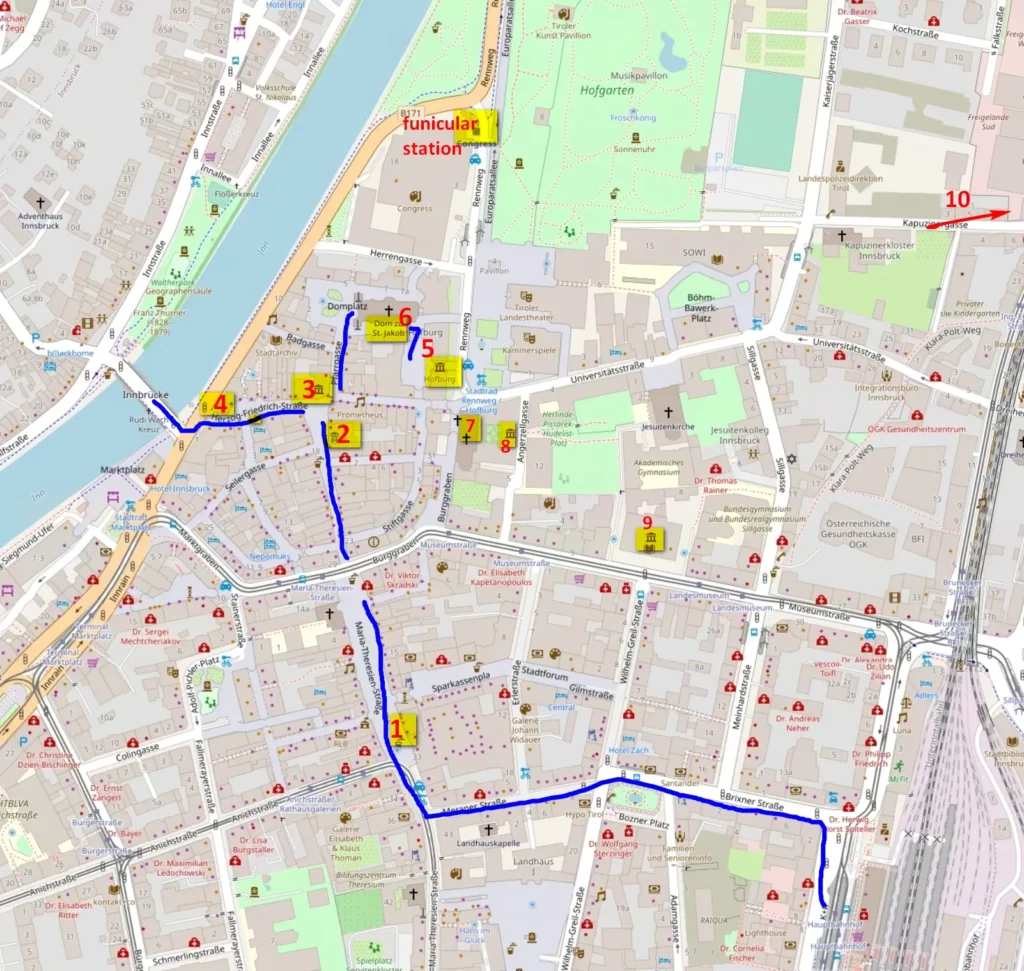
Innsbruck attractions
Innsbruck old town
The old town is quite small. There are only a few narrow streets – one block, which can be easily walked around in 40 minutes, without hurrying anywhere.
The station is also close by. And directly from the center, from the Congress building (opposite the imperial gardens), the funicular goes to the Hungerburg (and to the zoo).
We leave from the station to the column of St. Anna (number 1 on the plan). The houses on the surrounding streets were built in the 18th and 20th centuries.
The column was erected in 1703 to commemorate the withdrawal of the Bavarian troops from Tyrol. From the column, Maria Theresa street becomes a pedestrian street. There are restaurants here, and if you go deeper to the sides of this street, then you will unexpectedly find shopping galleries. They are made in the form of covered lanes.

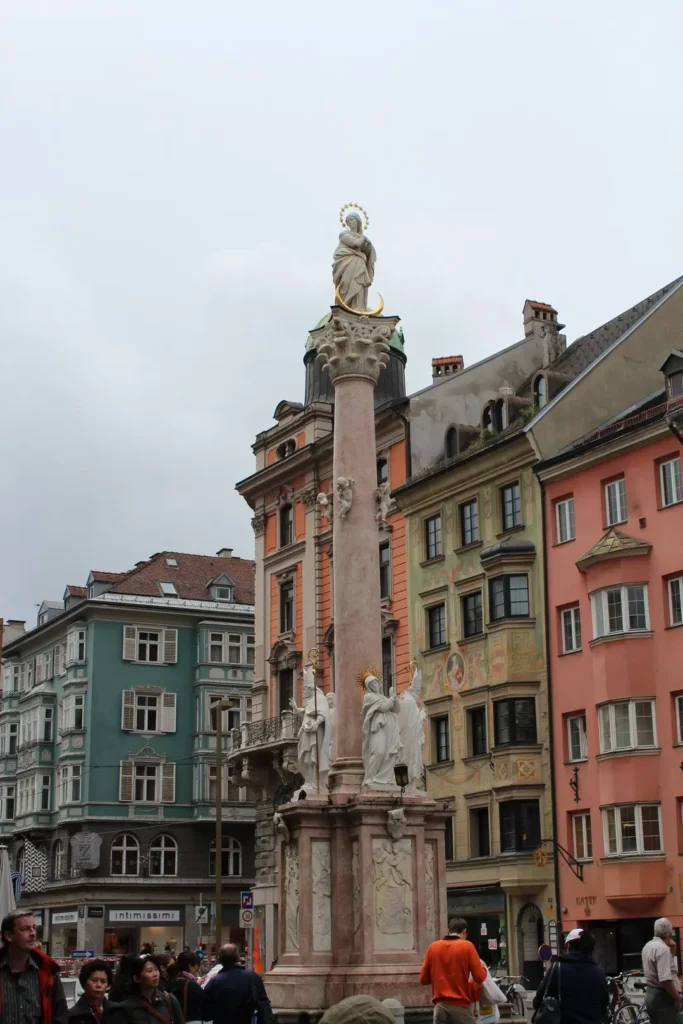
Crossing the tram lines, we find ourselves in the oldest part of the city. The narrow street Herzog Friedrich leads to the palace, in front of which it expands to form a square.
In addition to the palace, there is the town hall (2) – a gray-brown building with a tower (mid-14th century). There is an observation deck on the tower (June – September 10.00-20.00, in winter until 17.00). Opposite the town hall is the stucco Helblinghaus. It was built in the 15th century, and the Rococo facade was created in the 18th century.
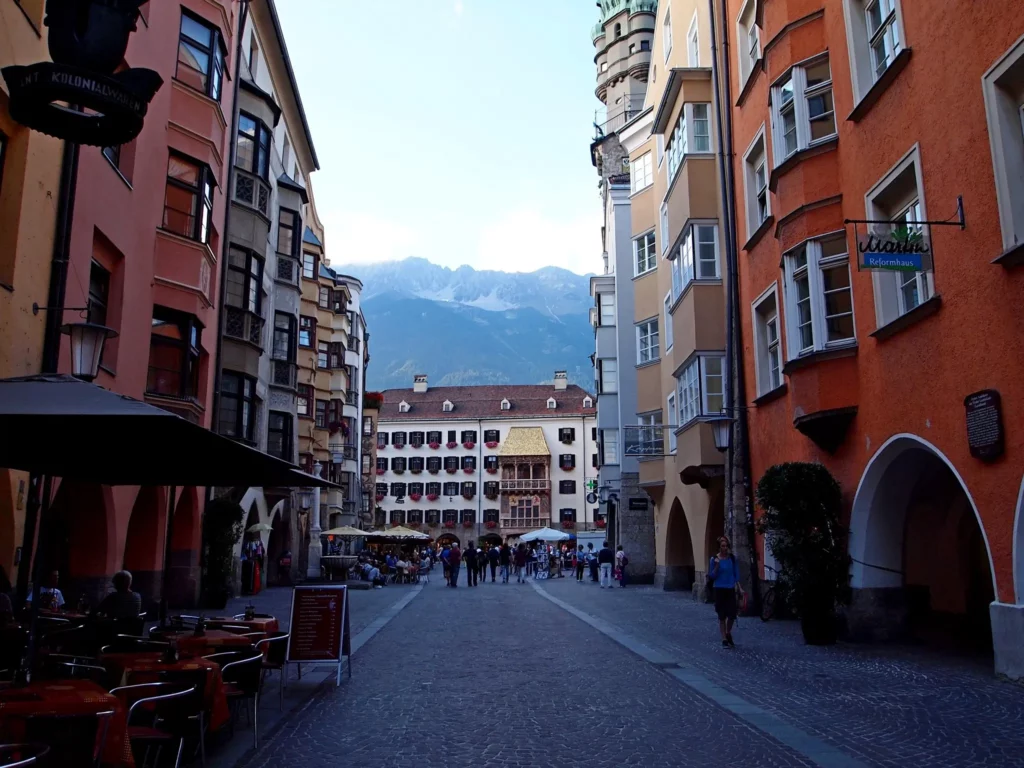
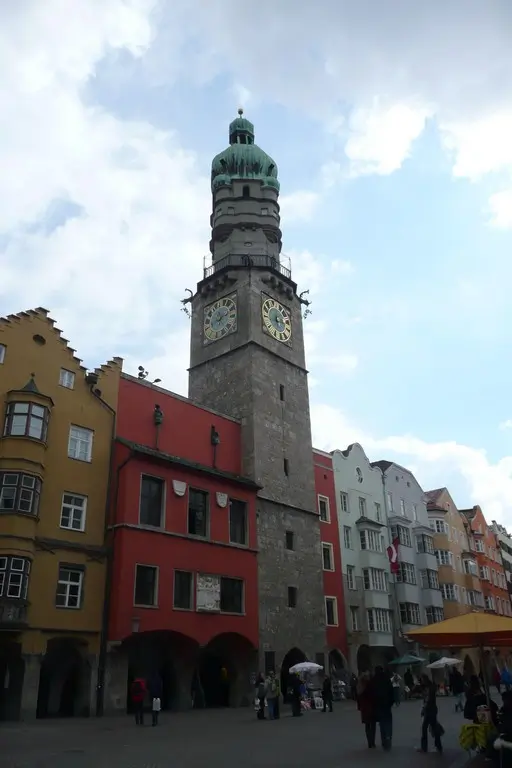
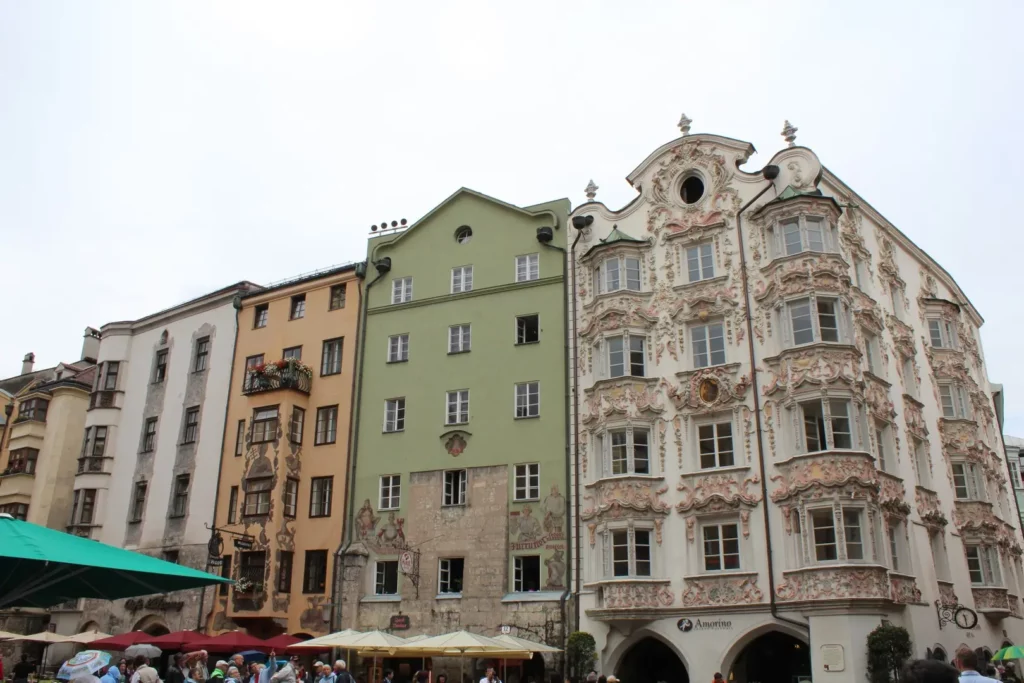

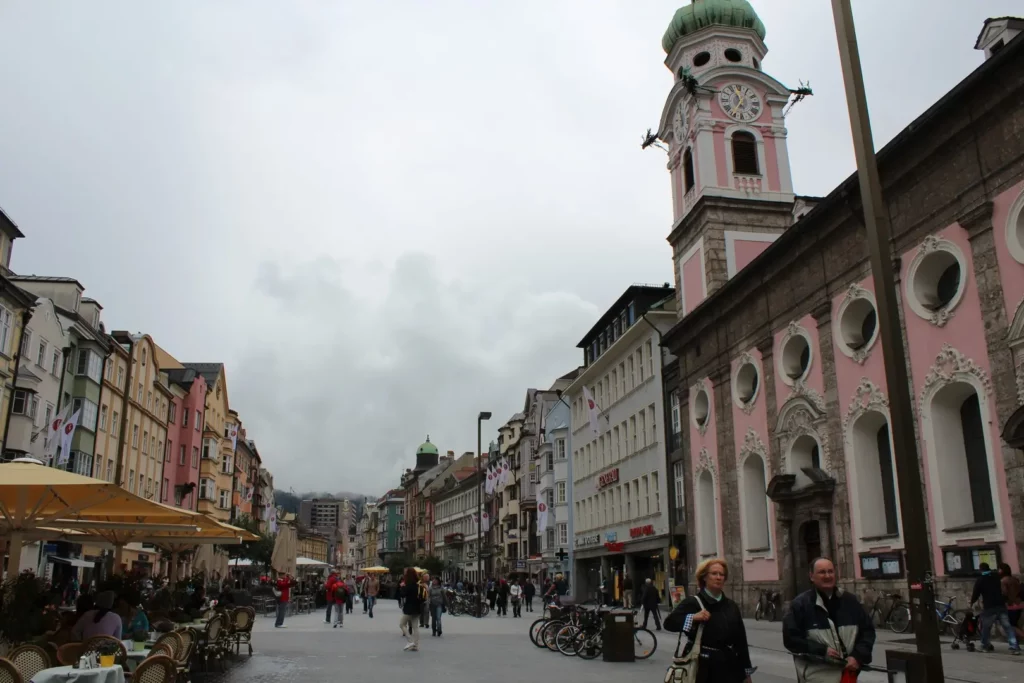
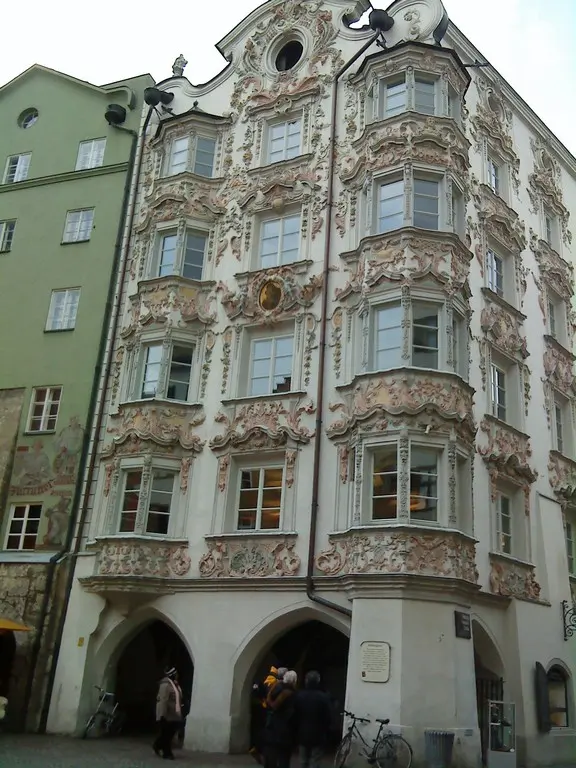
Golden roof
Tournaments, meetings and executions were held in the square in front of the palace. To observe the tournaments, Maximilian 1, “the last knight”, ordered to build the Golden Roof (3) – a loggia covered with gilded copper tiles (1500) for his second marriage.
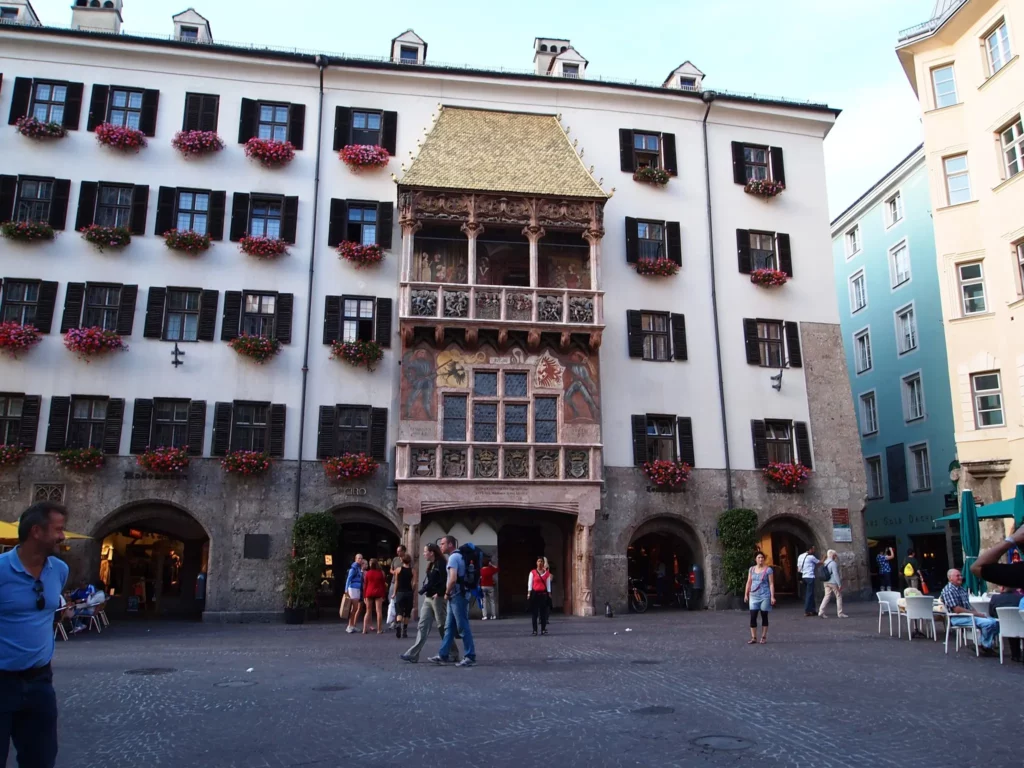

The loggia is attached to the palace of Duke Frederick 4, which was called Neuhof (15th century). It is decorated with the coats of arms of Austria, Hungary, Holy Roman Empire, German Empire, Burgundy and Milan. One central relief depicts Emperor Maximilian with both wives, Maria of Burgundy (died in a hunting accident) and Maria Bianca Sforza. On the other – Maximilian with the chancellor and the jester, and on the sides – Moorish dances. The loggia inside is painted with frescoes depicting court life.
Inside the building there are the hall where the Innsbruckians marry, and the museum dedicated to Maximilian 1. If visiting it, you can also look into the loggia. The museum exhibits paintings, portraits, medallions and gold jewelry from that era and tells about the life of Maximilian 1 in a multimedia form.
After enjoying the view of the main attraction of the city, now turn left to the river. On the way, we pass the hotel and restaurant “Golden Eagle”, founded in 1390. Famous people stayed here, a list of which, engraved on a stone board of ernorm dimensions, is displayed near the restaurant.
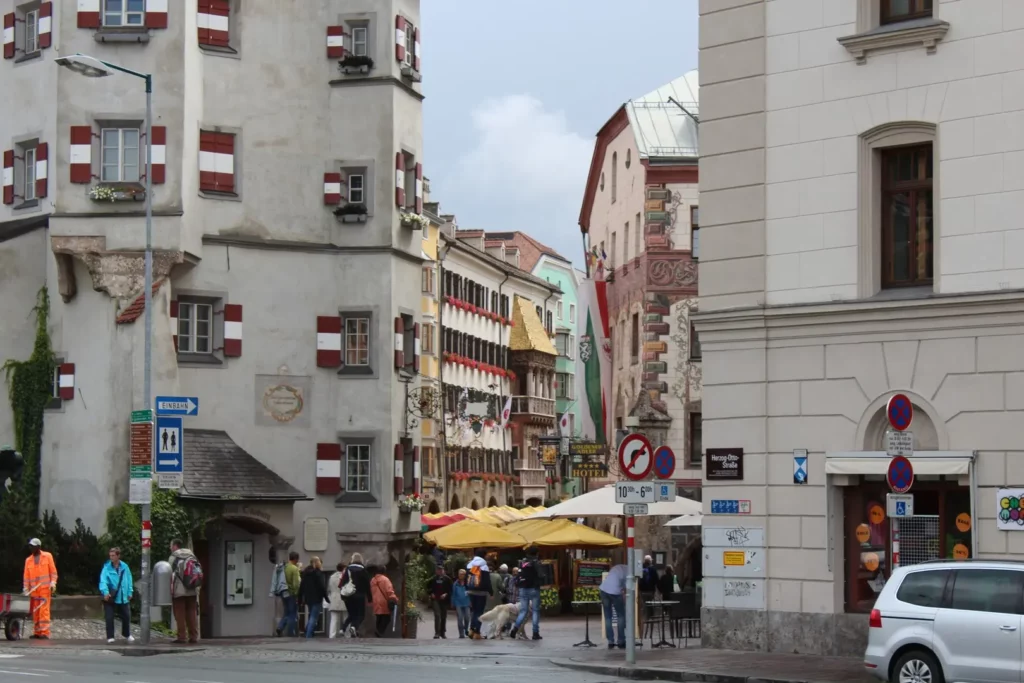
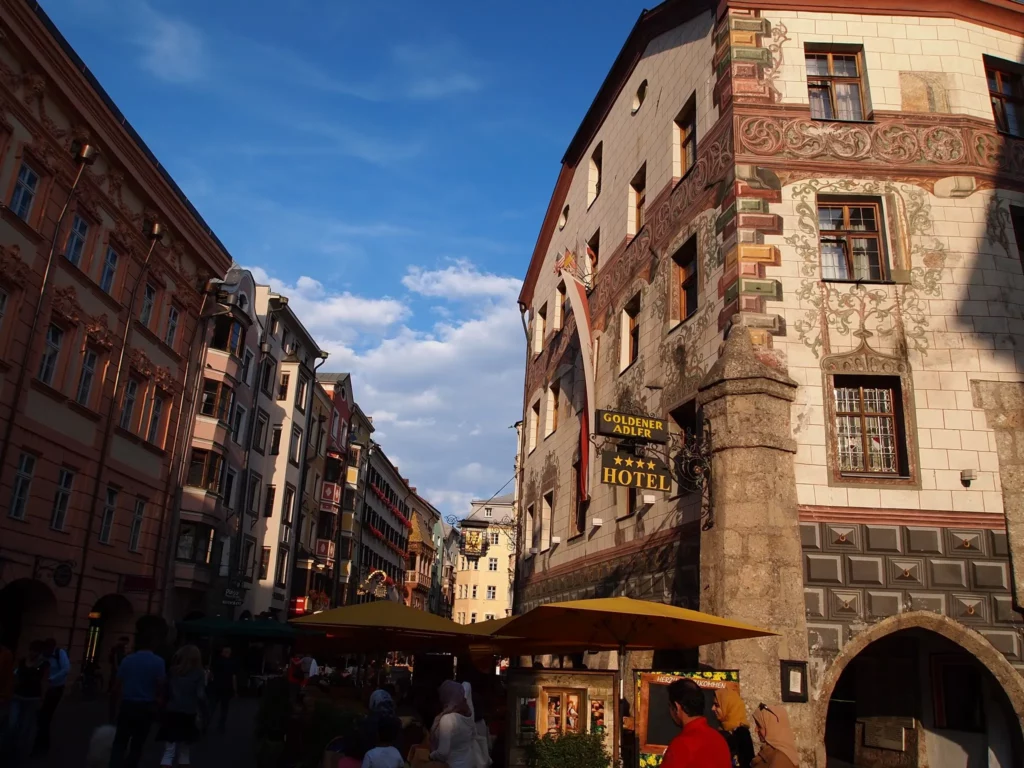
There is a gray building at the corner of the street on the banks of the river. If one don’t tell you, you won’t guess that this is Ottoburg (4), the first fortress built here (mentioned since 1460), so much the fortress looks like an ordinary house (number 5 on the plan).
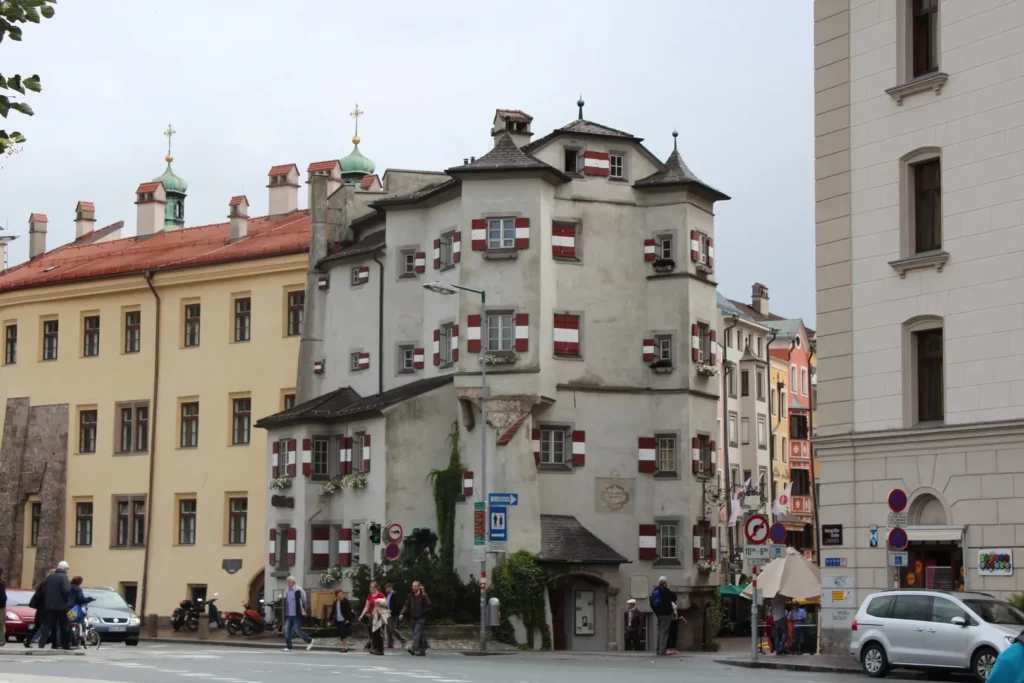
A row of colorful houses on the other side of the river is the oldest part of the city. The buildings date back to the 15-17th centuries.
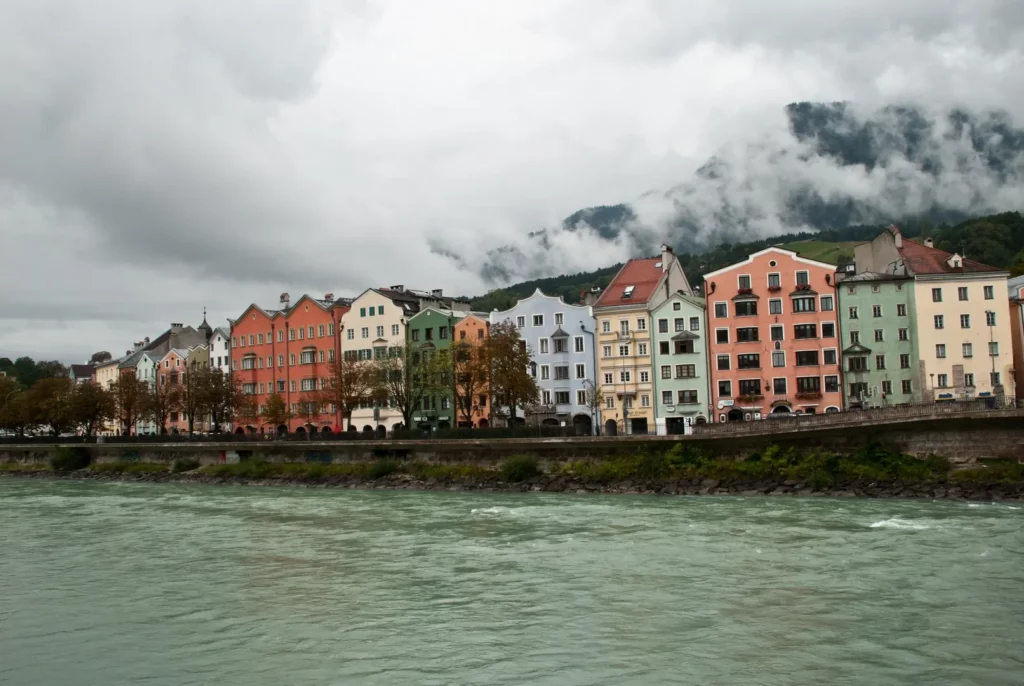
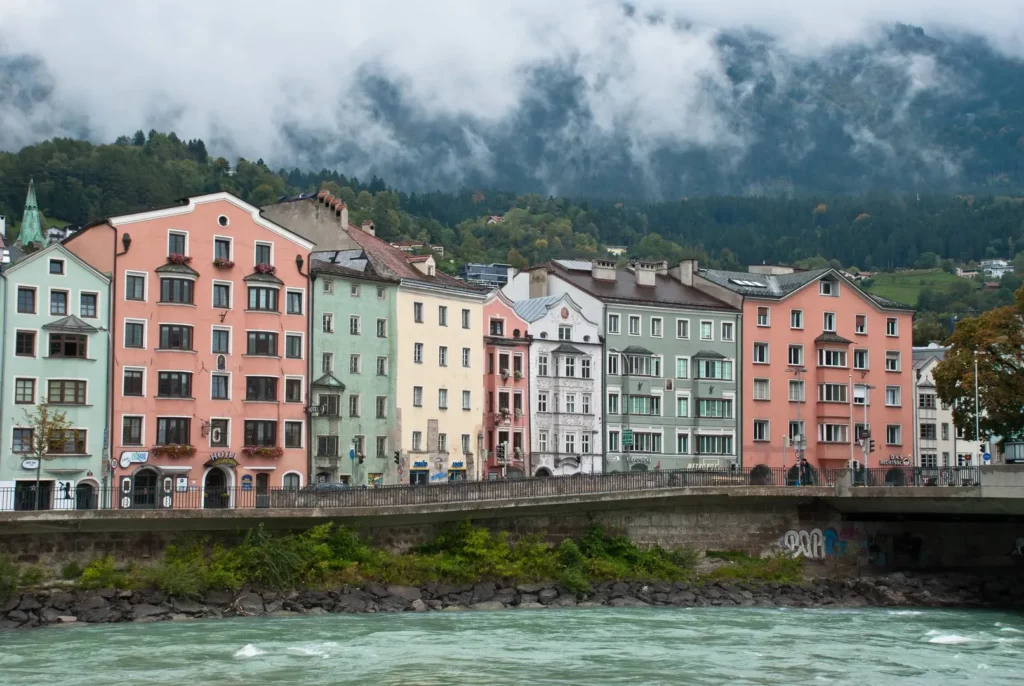
Follow me
Hofburg
But we will not cross to the other side – there is nothing to look at – but let’s return to the Golden Roof and now go a little further, to the Cathedral of St. Jacob (6). This baroque cathedral was built in the 18th century. The stucco molding and frescoes were created by the Azam brothers from Munich. The main treasure of the cathedral is the icon of Mary the Intercessor by Cranach the Elder, placed in the main altar.
After resting on a small square in front of the cathedral, we will walk a narrow street to the right of it and find ourselves in the courtyard of the Hofburg imperial palace (5).
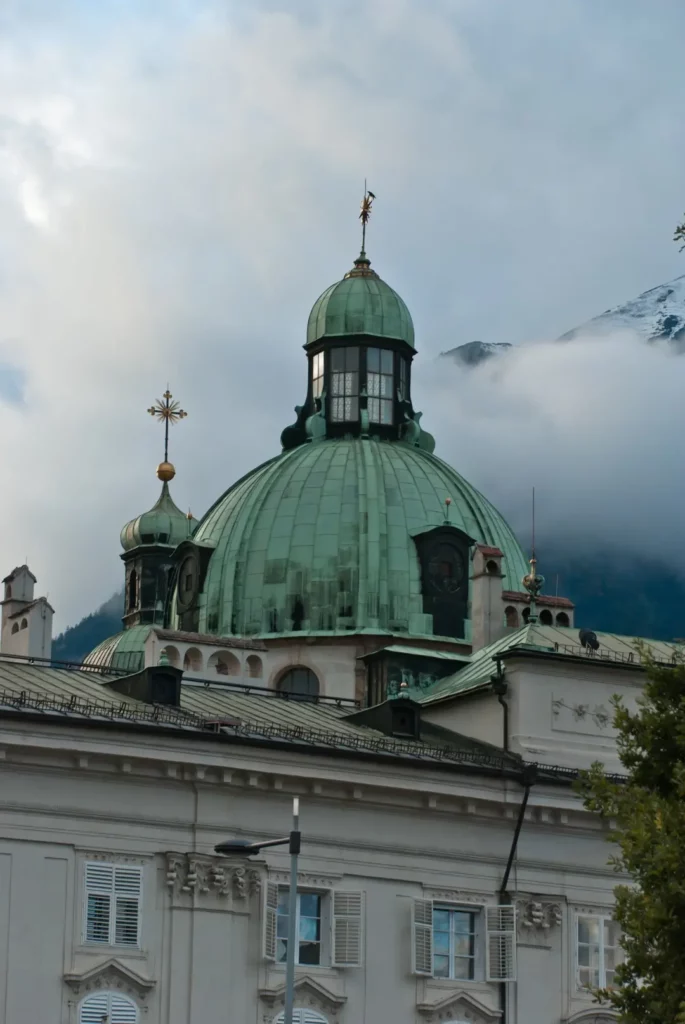
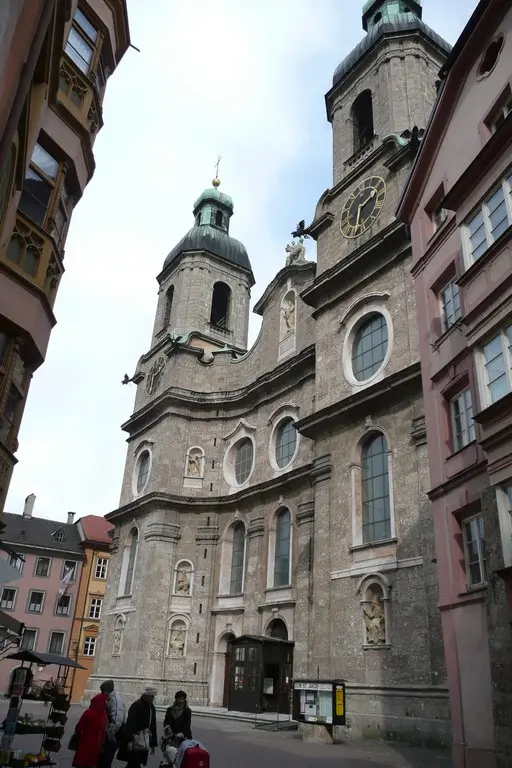
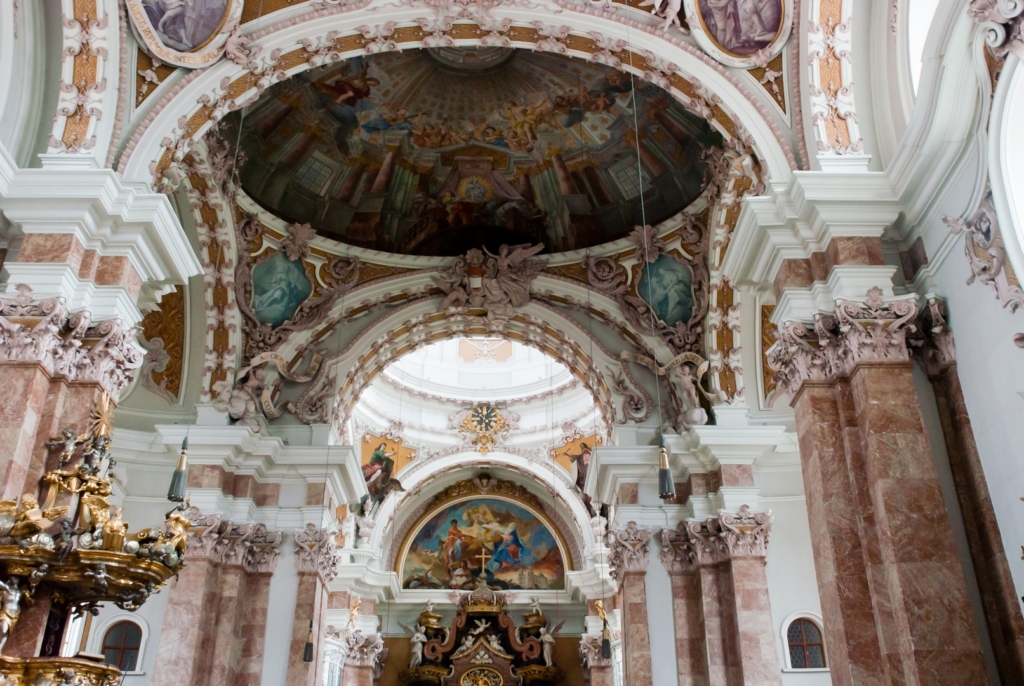

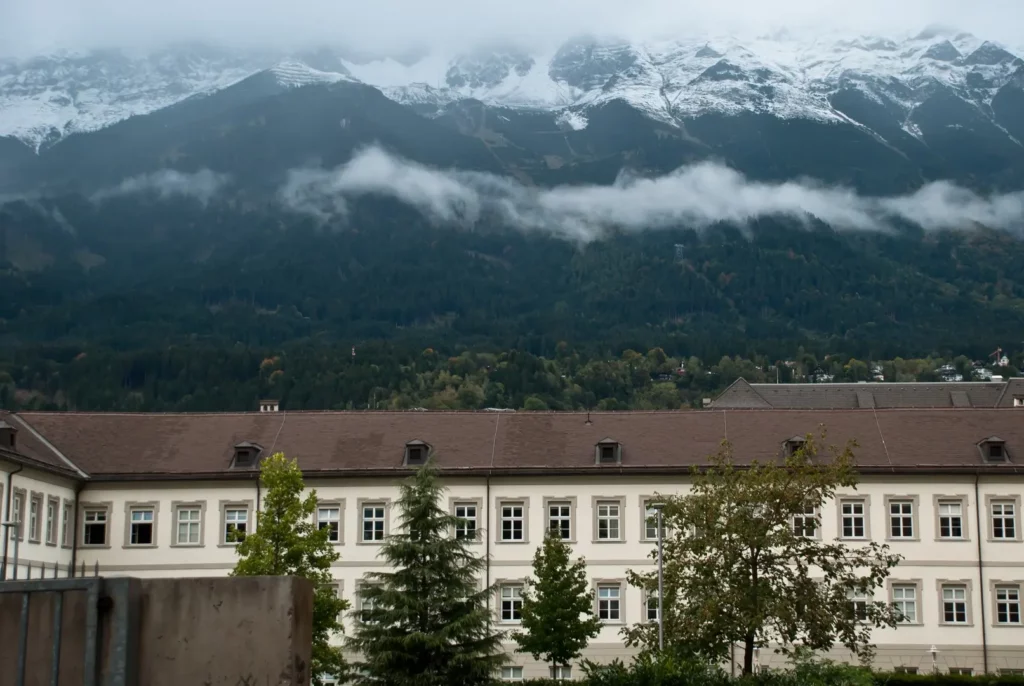
The construction of the palace began in the 15th century, because the Neuhof building (not to say that it was very old) had already ceased to satisfy the needs of the rulers. The palace was the residence of Maximilian 1, then of the dukes and imperial governors. In the middle of the 18th century Maria Theresa commissioned the renovation of the medieval building. It was completely rebuilt in the Rococo style. Only two corner towers remain from the old building.
The palace has recently been completely renovated. Inside you can see the original interiors, a large ceremonial hall with portraits of members of the imperial family (number 8).
Hofkirche
Finally, the last item on the list of historical heritage is the palace chapel (Hofkirche, 7). The chapel was built by order of the Emperor Ferdinand 1 in order to set up the tomb of his grandfather, Maximilian 1.
Maximilian, who thought out all the details of his burial, commissioned the construction of a cenotaph in Wiener Neustadt. However, Ferdinand chose to build a church and cenotaph in Innsbruck, leaving the emperor himself to rest in Wiener Neustadt. The work lasted 80 years (completed in 1584). Used black and red marble. Numerous reliefs were created with scenes from the life of the emperor. But the most interessant, perhaps, are 28 bronze statues depicting the ancestors of the emperor and heroes of the past. Three statues were made according to sketches by Albrecht Durer.
The work was completed by Archduke Ferdinand II (second son of Ferdinand I), the one who collected the collection of valuable art objects in the Ambras castle. Ferdinand 2 was married by a morganatic marriage in the Philippines Welser. For the burial of himself and his wife, he commissioned the creation of the so-called silver chapel by the Hofkirche.
Also buried in the Hofkirche is the Tyrolean people’s hero Andreas Hofer. He successfully fought against Napoleon and allied Bavarian troops and drove them out of Tyrol. But when defeated Austria gave Tyrol to the Bavarians, he was betrayed by one of his neighbors for a reward and executed. And the Tyrolean Judas, as he is called, ended up in poverty in Bavaria.

Walking around the center, we can look into the imperial garden (opposite the palace).
Other museums
In addition to the already mentioned museums, in the city you can visit two museums located next to the Hofkirche.
This is the Tyrolean Folk Art Museum (Tiroler Volkskunstmuseum, 8). And Ferdinandeum (9) – the art and history museum of the region. It presents works of art from medieval to modern, has a significant collection of Dutch painters, musical instruments, historical finds, etc.
Another museum dedicated to the culture and history of the region is located in the former arsenal built during the reign of Maximilian 1 (Museum im Zeughaus, 10). Here you will see prehistoric exhibits, exhibits dedicated to the mining of salt and silver, Tyrol’s participation in the wars of the 19th and 20th centuries, the globes of the cartographer Peter Anich.
The museum of bells (Glockenmuseum Grassmayr, on the map in next post) may be interesting for children too. Here you can learn how the bells are cast and listen to how they sound, and if you’re lucky, you can even see the process with your own eyes. The large bells are cast approximately once a month. The museum is located near the station (go south from it, to the Bergisel springboard)
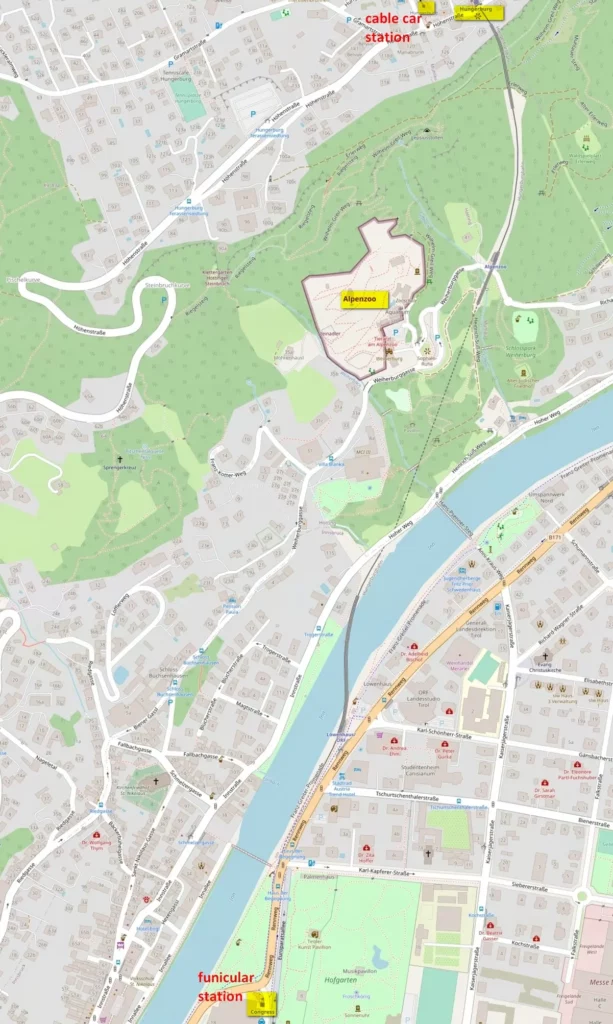
Innsbruck Funicular, Zoo and Nordkette
From the park, you can go upstairs using the funicular (the station is almost next to the palace) or cross the river and go to the zoo on foot.
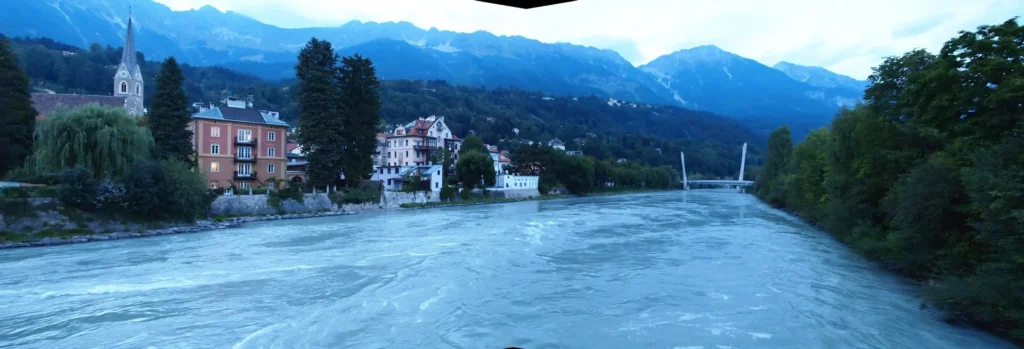
The solid mountains wall blocking the path to the north is called the Nordkette. You can get there by using the Hungerburg funicular from the center, and then by using two lines of the cable car.
There is a wonderful view of the city from above, but I think it is most interesting in the morning, while the sun is shining from the side. At the very top (2269 m) there is an observation deck that allows you to look at the other side of the mountains. The cable car website has enough photos to help you decide if you need to go there. The first section of the cable car is open until late on Fridays.
On the photo here is Nordkette from Patscherkofel.

The zoo is the second funicular station from the Congress (the first is on the river). It is also possible to climb on foot (20 minutes).
The zoo is located on a rather steep slope. You need to take about an hour and a half to visit (at least an hour). Mountain animals living or lived in the region are presented: various birds, mountain sheep, lynxes, bears, wolves, beavers and otters, fish, snakes, bison, roe deer, wild boars, foxes, elks.
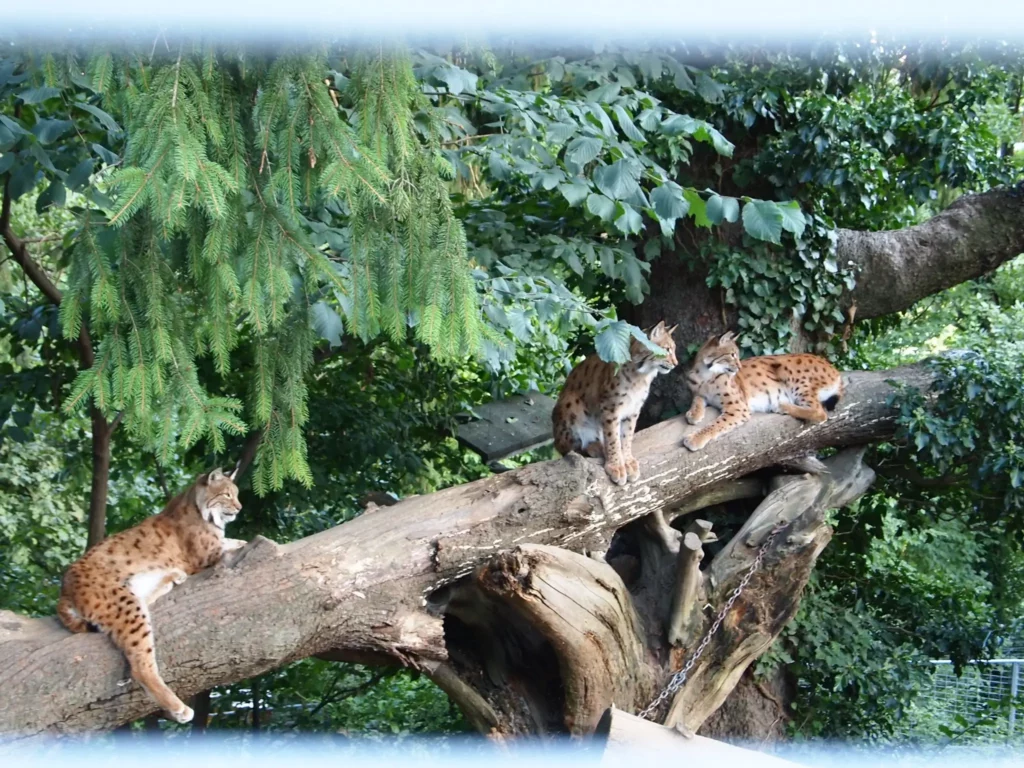
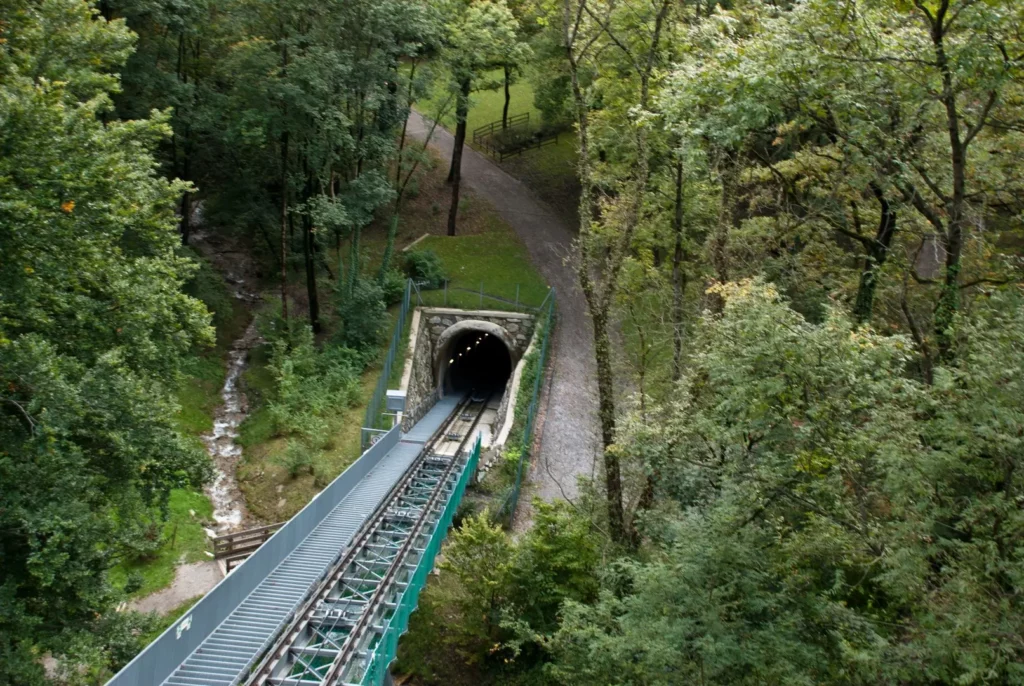
Near mountains
The city is well connected to the surrounding mountains by mountain trams and buses. With their help, you can get to the cable cars to the peaks, visit the Ambras castle.

Read about the Ambras palace and the cable car on this slope in the next topic.
The sights of the region are presented on the maps:
Vorarlberg attractions. From Bregenz to Ischgl
Around Innsbruck. From Reutte to Brenner
Inn valley attractions on the map – from Innsbruck to Kufstein
Do you enjoy the site without cookies? This means that I work for you at my own expense.
Perhaps you would like to support my work here.
Or change your cookie settings here. I don’t use personalized ads


